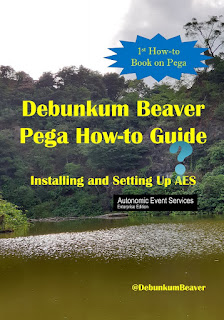Debunkum Beaver How-to Guide: Installing and Testing AES
Before going to the next section, a quick reminder:
The 40% discount for May Day promotion is ending on 18th May 2019. This is your last chance to get it at the discounted price:
Debunkum Beaver Pega CLSA Guide - Preparing for Pega CLSA 7.3/7.4 Certification (Book 1)
Why Create a How-to Guide?
Actually, information on Pega how-to can be
found in Pega Community, Pega Academy, as well as throughout the Internet.
Even if the information is not available,
all that is needed is simply to create a new Pega Community post; and somehow,
after some time, there would be people from the community, Pega GCS or even
Pega Engineering, jumping in to provide the answer, so isn't such a How-to
guide unnecessary?
Well, technically, you could argue in that
way. However, in any engagement, one of the most challenging things is
"deadline". Often, a go-live date would be defined well before
requirement specification is signed off.
Therefore, there is basically no time to
search for information, wait for replies, or learn and explore how to implement
various features in an actual project scenario when it is required.
Apart from that, the replies are often not
an end-to-end, step-by-step guide, complete with screenshots and do not include
validation and testing steps. Thus, it would require prior Pega knowledge and
additional effort to clarify, test and finally implement it.
To add on to the challenges, the profile of
the team members often creates another dimension of issues. This problem has 2
extremities:
- New Users of Pega: Those who are totally new to Pega
- Senior and Experienced Pega SSA/LSA: Those who have many years of experiences, some even spanned across Pega V5.x and V6.x
For New
Users of Pega, they do not know how to do a lot of things in Pega, thus a lot
of hand-holding and samples are required to guide them along and get them to be
efficient.
There is technically not much issues with
them, just the need to provide them with some examples and they would be able
to get started and replicate the implementation across the application.
The downside is that a lot of time is
required to create relevant samples and help them to debug any issues that
occur.
On the other hand, Senior and Experienced
Pega SSAs/LSAs, although are self-starters and able to start implementation
without much guidance, they introduced another kind of problem – their solutions
to all problems are often “activities” and “agents”!!!
Any other issues that cropped up along the
way, would often be yet another activity, custom Java codes or some HTML and
JavaScripts; Worst, creating new Boolean variables to do a When condition
throughout the whole application to handle difference scenario and business
changes!!!
With all those issues, in order to
understand the whole logic (and ensure it is correct), you need to kept track
of all the Boolean variables that are set/unset in all activities, data
transforms, flows, UIs, button clicked, etc.. Worst, the final decision is a
mesh of logics of all of the above! ☹
Technically, they can implement the
required features, but whatever they had touched, can no longer be easily
modified by another SSA/LSA without the corresponding number of years of experience,
not to mention about the underlying performance and maintenance issues that
were introduced! ☹
In
view of all these challenges, Debunkum Beaver has decided to embark on this
path: A How-to Guide for Pega.
For New Users of Pega, this series provide
a step-by-step guide to implement any given feature; for Senior and Experienced
Pega SSAs/LSAs, this guide shows the best practices and a standardised way of
implementing the intended features, leveraging on the newer Pega capabilities
to simplify the implementation (as much as possible).
With the Debunkum Beaver How-to Guide
series, you would have an arsenal of tools at your disposal. Whenever there is
a new project or new feature required, all you have to do is just to pull out
one of these guides. Cool right? 😎
Can you visualise a situation, where all
similar features have the same way of implementation, with the same sequence of
steps and number of rules; and anyone who looked at the rules knew exactly how
and why each rule was implemented as such; any deviations and bugs that were
introduced due to carelessness would simply stand out by itself, easily
identifiable and easy to fix, wouldn't this be a wonderful Pega World? 😊
Well, that is the core objective of the Debunkum Beaver How-to Guide series!
I will talk more about that in the upcoming chapters! Remember to follow @DebunkumBeaver at Twitter for updates!

No comments:
Post a Comment